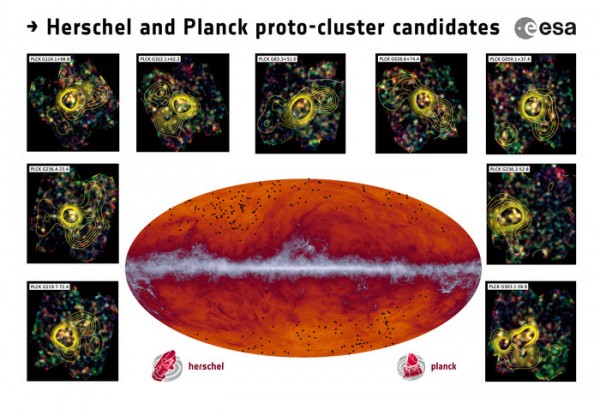Astronomers Find Baby Galaxy Clusters that Reveals Dark Matter at Work
| Ana Verayo | | Apr 02, 2015 07:14 AM EDT |
(Photo : ESA and the Planck Collaboration/ H. Dole, D. Guéry & G. Hurier, IAS/University Paris-Sud/CNRS/CNES) The Planck all-sky map shows the band running through the middle corresponds to dust in our Milky Way galaxy. The black dots indicate the location of the proto-cluster candidates identified by Planck and subsequently observed by Herschel.
Researchers from the European Space Agency have used two of their space telescopes to uncover a treasure chest of sorts in the form of ancient galaxy clusters that could reveal how the universe evolved and came about through billions of years.
This new study details how astronomers used the ESA's Planck space observatory to identify these distant galaxy clusters that could be the precursors to the universe. After identifying them, data was then transferred to the Herschel telescope for scientists to have a more in depth look.
Like Us on Facebook
According to lead author Hervé Dole of the Institut d'Astrophysique Spatiale in France, this has been a huge surprise to find so many intense star forming, dusty galaxies that could be an important missing piece in stellar structure formation.
Planck detected this treasure trove of baby galaxy clusters but it was Herschel data that allowed scientists and astronomers to examine closely the composition of each of these galaxy clusters that revealed its origins.
This step is pivotal in further understanding the early beginnings of the universe. Experts believe it took millions of years for stars and galaxies to acquire the energy to assemble into giant clusters.
When these clusters were formed, their powerful gravitational forces triggered a new generation of stars and galaxies. Scientists believe dark matter, which is the invisible force that makes-up most of the mass of the universe, helped these stars develop and flourish into the process of star formation but it's still an enigma as to how these large clusters assembled together.
Looking back at some of the compositions of the oldest galaxy clusters, scientists estimate that they date back to 11 billion years ago.
According to Dole, there's still a lot to learn from this new star population, as these kinds of cosmic objects have been detected in earlier data from Herschel and other telescopes, but Planck's all-sky capability has now revealed more candidates for further study.
This study was published in the journal Astronomy and Astrophysics.
TagsAstronomers Find Baby Galaxy Clusters that Reveals Dark Matter at Work, ESA, planck telescope, herschel telescope, baby galaxy clusters, dark matter, baby galaxy clusters ancient formations structures
©2015 Chinatopix All rights reserved. Do not reproduce without permission
EDITOR'S PICKS
-

Did the Trump administration just announce plans for a trade war with ‘hostile’ China and Russia?
-

US Senate passes Taiwan travel bill slammed by China
-

As Yan Sihong’s family grieves, here are other Chinese students who went missing abroad. Some have never been found
-

Beijing blasts Western critics who ‘smear China’ with the term sharp power
-

China Envoy Seeks to Defuse Tensions With U.S. as a Trade War Brews
-

Singapore's Deputy PM Provides Bitcoin Vote of Confidence Amid China's Blanket Bans
-

China warns investors over risks in overseas virtual currency trading
-

Chinese government most trustworthy: survey
-

Kashima Antlers On Course For Back-To-Back Titles
MOST POPULAR
LATEST NEWS
Zhou Yongkang: China's Former Security Chief Sentenced to Life in Prison

China's former Chief of the Ministry of Public Security, Zhou Yongkang, has been given a life sentence after he was found guilty of abusing his office, bribery and deliberately ... Full Article
TRENDING STORY

China Pork Prices Expected to Stabilize As The Supplies Recover

Elephone P9000 Smartphone is now on Sale on Amazon India

There's a Big Chance Cliffhangers Won't Still Be Resolved When Grey's Anatomy Season 13 Returns

Supreme Court Ruled on Samsung vs Apple Dispute for Patent Infringement

Microsoft Surface Pro 5 Rumors and Release Date: What is the Latest?










